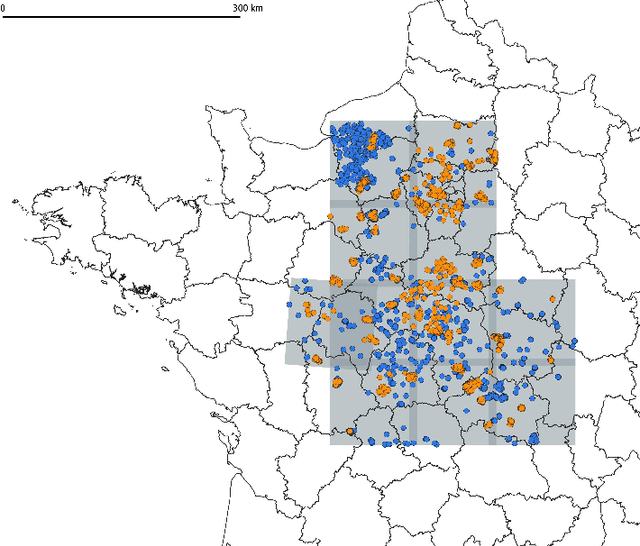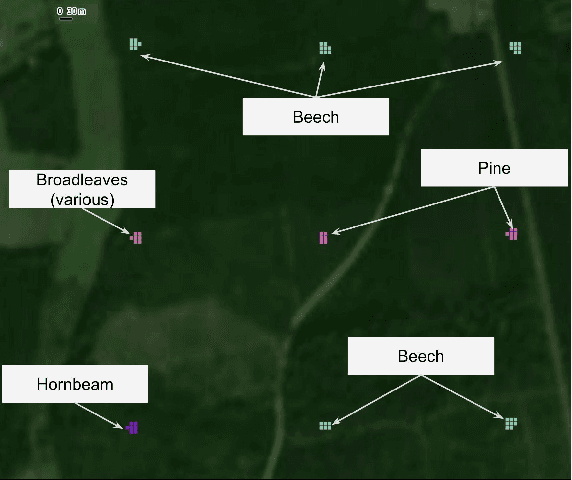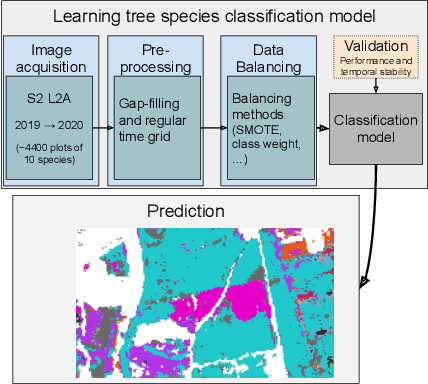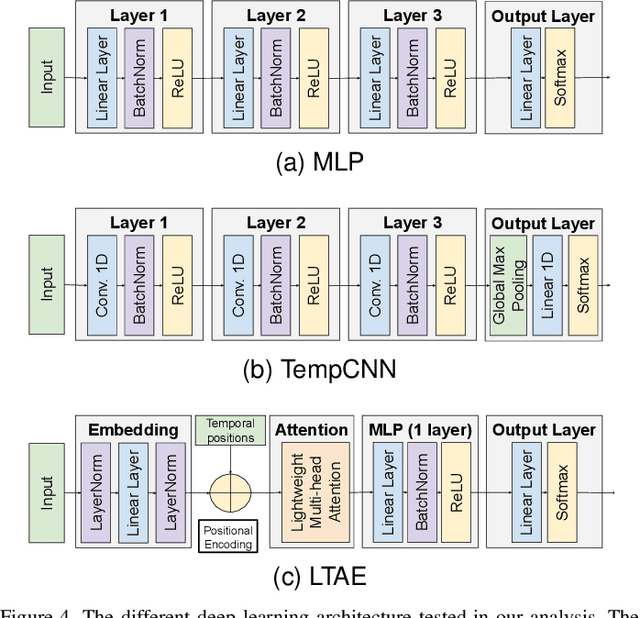David Morin
CESBIO
Tree species classification at the pixel-level using deep learning and multispectral time series in an imbalanced context
Aug 05, 2024



Abstract:This paper investigates tree species classification using Sentinel-2 multispectral satellite image time-series. Despite their critical importance for many applications, such maps are often unavailable, outdated, or inaccurate for large areas. The interest of using remote sensing time series to produce these maps has been highlighted in many studies. However, many methods proposed in the literature still rely on a standard classification algorithm, usually the Random Forest (RF) algorithm with vegetation indices. This study shows that the use of deep learning models can lead to a significant improvement in classification results, especially in an imbalanced context where the RF algorithm tends to predict towards the majority class. In our use case in the center of France with 10 tree species, we obtain an overall accuracy (OA) around 95% and a F1-macro score around 80% using three different benchmark deep learning architectures. In contrast, using the RF algorithm yields an OA of 93% and an F1 of 60%, indicating that the minority classes are not classified with sufficient accuracy. Therefore, the proposed framework is a strong baseline that can be easily implemented in most scenarios, even with a limited amount of reference data. Our results highlight that standard multilayer perceptron can be competitive with batch normalization and a sufficient amount of parameters. Other architectures (convolutional or attention-based) can also achieve strong results when tuned properly. Furthermore, our results show that DL models are naturally robust to imbalanced data, although similar results can be obtained using dedicated techniques.
Estimation of forest height and biomass from open-access multi-sensor satellite imagery and GEDI Lidar data: high-resolution maps of metropolitan France
Oct 23, 2023Abstract:Mapping forest resources and carbon is important for improving forest management and meeting the objectives of storing carbon and preserving the environment. Spaceborne remote sensing approaches have considerable potential to support forest height monitoring by providing repeated observations at high spatial resolution over large areas. This study uses a machine learning approach that was previously developed to produce local maps of forest parameters (basal area, height, diameter, etc.). The aim of this paper is to present the extension of the approach to much larger scales such as the French national coverage. We used the GEDI Lidar mission as reference height data, and the satellite images from Sentinel-1, Sentinel-2 and ALOS-2 PALSA-2 to estimate forest height and produce a map of France for the year 2020. The height map is then derived into volume and aboveground biomass (AGB) using allometric equations. The validation of the height map with local maps from ALS data shows an accuracy close to the state of the art, with a mean absolute error (MAE) of 4.3 m. Validation on inventory plots representative of French forests shows an MAE of 3.7 m for the height. Estimates are slightly better for coniferous than for broadleaved forests. Volume and AGB maps derived from height shows MAEs of 75 tons/ha and 93 m${}^3$/ha respectively. The results aggregated by sylvo-ecoregion and forest types (owner and species) are further improved, with MAEs of 23 tons/ha and 30 m${}^3$/ha. The precision of these maps allows to monitor forests locally, as well as helping to analyze forest resources and carbon on a territorial scale or on specific types of forests by combining the maps with geolocated information (administrative area, species, type of owner, protected areas, environmental conditions, etc.). Height, volume and AGB maps produced in this study are made freely available.
High-resolution canopy height map in the Landes forest based on GEDI, Sentinel-1, and Sentinel-2 data with a deep learning approach
Dec 20, 2022Abstract:In intensively managed forests in Europe, where forests are divided into stands of small size and may show heterogeneity within stands, a high spatial resolution (10 - 20 meters) is arguably needed to capture the differences in canopy height. In this work, we developed a deep learning model based on multi-stream remote sensing measurements to create a high-resolution canopy height map over the "Landes de Gascogne" forest in France, a large maritime pine plantation of 13,000 km$^2$ with flat terrain and intensive management. This area is characterized by even-aged and mono-specific stands, of a typical length of a few hundred meters, harvested every 35 to 50 years. Our deep learning U-Net model uses multi-band images from Sentinel-1 and Sentinel-2 with composite time averages as input to predict tree height derived from GEDI waveforms. The evaluation is performed with external validation data from forest inventory plots and a stereo 3D reconstruction model based on Skysat imagery available at specific locations. We trained seven different U-net models based on a combination of Sentinel-1 and Sentinel-2 bands to evaluate the importance of each instrument in the dominant height retrieval. The model outputs allow us to generate a 10 m resolution canopy height map of the whole "Landes de Gascogne" forest area for 2020 with a mean absolute error of 2.02 m on the Test dataset. The best predictions were obtained using all available satellite layers from Sentinel-1 and Sentinel-2 but using only one satellite source also provided good predictions. For all validation datasets in coniferous forests, our model showed better metrics than previous canopy height models available in the same region.
 Add to Chrome
Add to Chrome Add to Firefox
Add to Firefox Add to Edge
Add to Edge